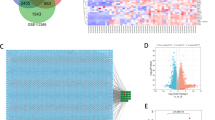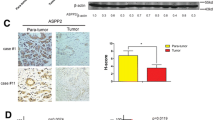Abstract
The protein of programmed cell death 5 (PDCD5) is believed to participate in regulation of apoptosis. Although PDCD5 is reducibly expressed in various human tumors, it is not clear which expression level of PDCD5 is in gastric cancer (GC). In this study, we have systematically employed the approaches of RT-PCR, Real- time PCR, Immunohistochemistry (IHC), Immunofluorescence staining (IFS) and Western blot to determine the PDCD5 expression in GC cells and primary tumors, at mRNA and protein level, respectively. Our data revealed that the positive rate of PDCD5 expression in the gastric tumor tissues was significantly less than that of the normal tissues (14 out of 102 vs 36 out of 51), whereas, the decreased expression of PDCD5 protein was well correlated with the up-regulated expression of Bcl-2 in these tissues, and the up-regulated expression and nuclear translocation of PDCD5 protein were verified in the apoptotic GC cells induced by Diallyl trisulfide (DATS). Furthermore, the survival curve has suggested that the more PDCD5 expressions were found in the patients, the longer the survival periods were. Therefore, our observations lay down a reasonable postulation that PDCD5 may play a key role to regulate the apoptotic processes in the GC cells and gastric tumors.
Similar content being viewed by others
References
Feng X. Regulatory roles and molecular signaling of TNF family members in osteoclasts. Gene 2005; 350(1): 1–13.
Ghobrial IM, Witzig TE, Adjei AA. Targeting apoptosis pathways in cancer therapy. CA Cancer J Clin 2005; 55(3): 178–194.
Gomez-Lazaro M, Fernandz-Gomez FJ, Jordan J. The role of protein p53 in neurodegenerative processes throughout the 25 years of its history. Rev Neurol 2004; 39(3): 243–250.
Nicholson DW. ICE/CED3-like proteases as therapeutic targets for the control of inappropriate apoptosis. Nat Biotechnol 1996; 14(3): 297–301.
Mani A, Gelmann EP. The ubiquitin-proteasome pathway and its role in cancer. J Clin Oncol 2005; 23(21): 4776–4789.
Hongtao Liu, Yugang Wang, Yingmei Zhang, et al. TFAR19, a novel apoptosis-related gene cloned from human leukemia cell line TF-1, could enhance apoptosis of some tumor cells induced by growth factor withdrawal. Biochem Biophys Res Comm 1999; 254(1): 203–210.
Min Rui, Yingyu Chen, Yingmei Zhang, Dalong Ma. Transfer of anti-TFAR19 monoclonal antibody into HeLa cells by in situ electroporation can inhibit the apoptosis. Life Sciences 2002; 71: 1771–1778.
Yingyu Chen, Ronghua Sun. Wenling Han, et al. Nuclear translocation of PDCD5 (TFAR19): An early signal for apoptosis? FEBS Letters 2001; 509: 191–196.
Dongsheng Liu, Yingang Feng, Yuan Cheng, Jinfeng Wang. Human programmed cell death 5 protein has a helical-core and two dissociated structural regions. Biochem Biophys Res Commun 2004; 318(2): 391–396.
Tian HK, Xia T, Jiang CS, Zhang HM, Wang K, Li XJ. TFAR19 enhances the opening of permeability transition pore in the mitochondrial membrane of mice liver. Sheng Wu Hua Xue Yu Sheng Wu Wu Li Xue Bao (Shanghai) 2002; 34(3): 279–284.
Ying Wang, Xianting Li, Lu Wang, et al. An alternative form of paraptosis-like cell death, triggered by TAJ/TROY and enhanced by PDCD5 overexpression. J Cell Sci 2004; 117: 1525–1532.
Ingrid Hedenfalk, Dvid Duggan, Yidong Chen, et al. Gene-expression profiles hereditary breast cancer. N Engl J Med 2001; 344(8): 539–548.
Xu XR, Huang J, Xu ZG, Qian BZ, Zhu ZD, Han ZG. Insight into hepatocellular carcinogenesis at transcriptome level by comparing gene expression profiles of hepatocellular carcinoma with those of corresponding noncancerous liver. Proc Natl Acad Sci USA 2001; 98(26): 15089–15094.
Liu ZH, Zhang D, Li KM, Liao QP. Expression of PDCD5 in tissues of normal cervix, CIN I–III and cervical cancer. J Pek Univer (Health sciences) 2004; 36(4): 407–410.
Lan H, Lu YY. Allitridi induces apoptosis by affecting Bcl-2 expression and caspase-3 activity in human gastric cancer cells. Acta Pharmacol Sin 2004; 25(2): 219–225.
McCabe ML, Dlamini Z. The molecular mechanisms of oesophageal cancer. Int Immunopharmacol 2005; 5(7–8): 1113–1130.
Kountouras J, Zavos C, Chatzopoulos D. Apoptotic and anti-angiogenic strategies in liver and gastrointestinal malignancies. J Surg Oncol 2005; 90(4): 249–259.
Shirin H, Hibshoosh H, Kawabata Y, Weinstein IB, Moss SF. p16Ink4a is overexpressed in H. pylori-associated gastritis and is correlated with increased epithelial apoptosis. Helicobacter 2003; 8(1): 66–71.
Soman NR, Correa P, Ruiz BA, Wogan GN. The TPR-MET oncogenic rearrangement is present and expressed in human gastric carcinoma and precursor lesions. Proc Natl Acad Sci USA 1991; 88(11): 4892–4896.
Tavassoli M, Guelen L, Luxon BA, Gaken J. Apoptin: Specific killer of tumor cells? Apoptosis 2005; 10(4): 717–724.
Feng Y, Hu J, Xie D, et al. Subcellular localization of caspase-3 activation correlates with changes in apoptotic morphology in MOLT-4 leukemia cells exposed to X-ray irradiation. Int J Oncol 2005; 27(3): 699–704.
Author information
Authors and Affiliations
Corresponding author
Rights and permissions
About this article
Cite this article
Yang, YH., Zhao, M., Li, WM. et al. Expression of programmed cell death 5 gene involves in regulation of apoptosis in gastric tumor cells. Apoptosis 11, 993–1001 (2006). https://doi.org/10.1007/s10495-006-6714-6
Published:
Issue Date:
DOI: https://doi.org/10.1007/s10495-006-6714-6




